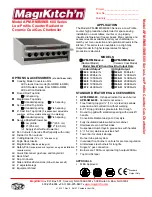
42
BOILER CONTROL: OPERATION
The next value, Flame Failures, is the number of
times the burner has dropped out due to flame
failure. Several flame failures may have occurred
during the factory firetests and installation. If there
are a large number of flame failures showing on
this screen, contact your Peerless
®
Representative.
On Screens #5 and #6, the Flame Measurement
values 1-4 are logged in the last two seconds
of the most recent ignition sequence in 1/2
second intervals. This helps service contractors to
diagnose ignition issues.
d. Ignition Attempts: Screen #7 provides information
about ignition attempts. Obviously, the total
ignition attempts are the sum of the successful
and failed attempts. Several ignition failures
may occur during factory firetest and equipment
commissioning. However, if there are a large
number of failed ignition attempt showing on this
screen, contact your Peerless
®
Representative. If
there is an unusually large number of total ignition
attempts, there may be a problem with the boiler
short cycling.
e. Burner Run Time
:
Screen #8 provides information
about the total run time of each burner. The total
burner run time is the sum of the central heating
(CH) and domestic hot water (DHW) hours. The
total boiler run time is the sum of both burner run
times.
f. Blocking Errors: Screen #9 provides error history
about the last 16 blocking errors. Blocking errors
are errors that prevent the burner from operating
until the condition causing the error is corrected.
Sensor errors, low water, and blocked vent are
examples of this type of error. To review previous
errors, press the select key. The number in the
upper right changes from the status screen “9”
to a blinking “0” indicating that this is the most
recent error. Use the arrow keys to scroll through
previous errors from 0 to 15. If the screen
shows “#255” in the error number location,
this indicates that there is no error stored in this
location. All errors on screens higher than one
showing “#255” should also indicate no error.
Table 10.1 (in Section 10) provides a list of
blocking errors.
g. Lockout Errors: Screen #10 provides error history
about the last 15 locking errors. Locking errors are
errors that require a manual reset on the control
board (pushing the “Reset” key on the display) to
reset the burner once the condition causing the
error has been corrected. Ignition Failure, Flame
Failure and High Limit Temperature are examples
of this type of error. To review previous errors,
press the “Select” key. The number in the upper
right changes from the status screen number
“10” to a blinking “0” indicating that the screen
is showing the most recent lockout error. If the
burner is not in lockout, this position should show
“#255” in the error number location. Use the
arrow keys to scroll through previous errors from
1 to 15. As with blocking errors, “#255” always
indicates that no error is stored in this location.
Table 10.2 provides a list of lock out errors.
3.
Burner Settings
The burner settings menu allows the installation or
service contractor to change settings which effect the
burner operation. The following are descriptions of
the available settings.
a. Burner Mode: The burner modes are set by
default from the factory. The upper burner, which
corresponds to the display closest to the front of
the boiler, is always the “managing burner”. The
lower burner, with its display toward the rear, is
always the “dependent burner”. These values are
not intended to be changed in the field.
b. Modbus Address: If communicating with this boiler
via Modbus, this value indicates the address of this
boiler. This value can be set between 1 and 255
and should correspond with the address assigned
on the Modbus system.
c. Boiler Address:
P
ure
F
ire
®
boilers can be operated
in cascade with as many as 15 identical boilers by
adding 2 wire communication links between the
boilers. The following chart shows the role of the
boiler depending on the boiler address. Multiple
boiler operation is covered in-depth at the end of
this section of the manual. This screen is available
only on the managing burner.
Figure 8.17: Status – Ignition
Figure 8.18: Status – Burner Run Time
Figure 8.19: Status – Blocking Errors
Figure 8.20: Status – Locking Errors
Figure 8.21: Burner Settings – Burner Mode &
Boiler Address
Managing Burner Only
Содержание PUREFIRE PFC-1000
Страница 1: ...PUREFIRE Boilers PFC 850 PFC 1000 PFC 1500 Gas Installation Operation Maintenance Manual ...
Страница 23: ...21 WATER PIPING CONTROLS Figure 4 4 Recommended Piping One Boiler with Multiple CH Zones One DHW Tank ...
Страница 24: ...22 WATER PIPING CONTROLS Figure 4 5 Recommended Piping Multiple Boilers with Multiple CH Zones One DHW Tank ...
Страница 62: ...60 START UP PROCEDURE J LIGHTING OPERATING INSTRUCTIONS Figure 9 1 Lighting Operating Instructions ...
Страница 80: ...78 REPAIR PARTS Figure 13 3a Jacket Assembly PFC 850 1000 Figure 13 3b Jacket Assembly PFC 1500 ...
Страница 82: ...80 Figure 13 4 Control System REPAIR PARTS ...
Страница 84: ...82 Figure 13 5 Condensate System REPAIR PARTS ...
Страница 89: ...87 APPENDIX B BURNER LCD STATUS SCREENS CH Burn Cycle DHW Burn Cycle Special Functions DHW Tank Warm Hold ...
Страница 90: ...88 APPENDIX C USER MENU APPENDIX C USER MENU Figure C 1 User Menu Managing Burner ...
Страница 91: ...89 APPENDIX C USER MENU Figure C 1 User Menu Dependent Burner ...
Страница 92: ...90 APPENDIX D INSTALLER MENU STRUCTURE APPENDIX D INSTALLER MENU STRUCTURE ...
Страница 93: ...91 APPENDIX D INSTALLER MENU STRUCTURE ...
Страница 95: ...93 SERVICE LOG SERVICE LOG Date Serviced By Description of Service Serial Number ...
Страница 96: ...94 NOTES ...
Страница 97: ...95 NOTES ...
















































